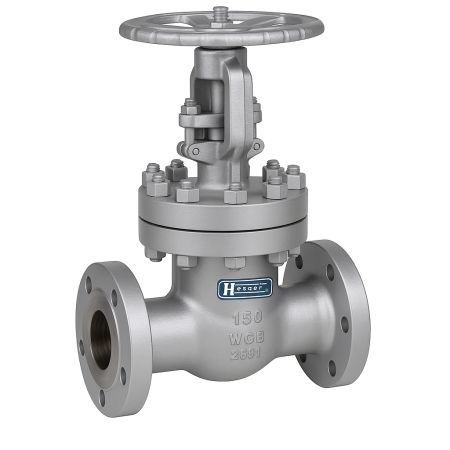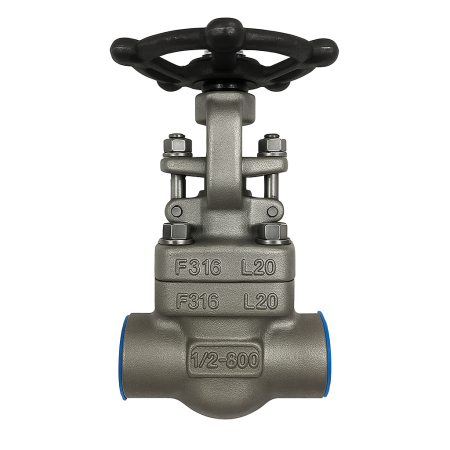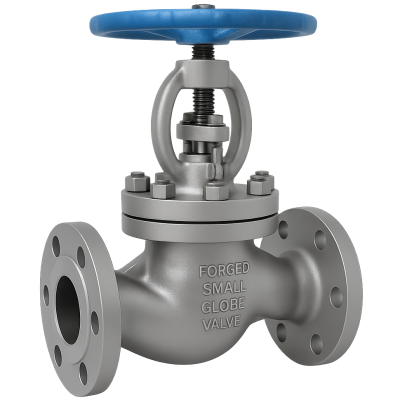Häger GmbH & Co. KG ANSI-Globe Valves
Globe valves are to be distinguished from gate valves. Both are responsible for opening and closing pipelines, but globe valves can be equipped with a regulating plug (throttle plug/regulation disc). This allows the fluid flow to be easily and precisely controlled as desired. Another difference between the two valves is that gate valves have a full bore passage, which is not present in globe valves.
Key Features of Globe Valves
Globe valves are control valves designed for precise regulation or shut-off of liquids and also allow maintenance work via handwheel operation; optionally, a bypass valve provides easy pressure equalization. Compared to gate valves, they offer finer flow control and are ideal for applications requiring controlled media flow.
Precise flow control
Globe valves enable precise control of media flow through their special cone design—ideal for applications where flow needs not only to be stopped but also finely regulated.
Integrated back seal
With an integrated back seat and optional Stellite hardfacing, globe valves are durable, easy to maintain, and reliable even at high pressures and temperatures.
Bypass valve compensation
An optional bypass valve provides pressure equalization before operation, making opening and closing easier—especially at high operating pressures, this offers a significant improvement in user comfort.
Häger Globe Valve According to ANSI Standard
Datasheets
Sizes range from 2″ to 24″, with pressure ratings of 150, 300, 600, 900, 1500, and 2500 LBS. The valve bodies are available in various materials including 1.0619, A216 WCB, 1.4408, 1.4306, 1.4404, 1.1138, 1.4308, 1.5419, 1.7357, 1.7379, CF8M, CF3M, CF3, WC1, WC6, WC9, LCB, and LCC.
Description of our Globe Valves:
- Regulating cone / throttling disc (Regulating Disc)
- Face-to-face dimensions according to ASME B16.10
- Declaration of conformity and CE marking according to DGRL 97/23/EC
- Available with flanged ends (ANSI B16.5) or weld ends
- Optional TA-LUFT compliant systems according to VDI 2440 (Technical Guidelines for Air Pollution Control)

- Regulating cone / throttling disc (Regulating Disc)
- Face-to-face dimensions according to ASME B16.10
- Declaration of conformity and CE marking according to DGRL 97/23/EC
- Available with flanged ends (ANSI B16.5) or weld ends
- Optional TA-LUFT compliant systems according to VDI 2440 (Technical Guidelines for Air Pollution Control)
Globe Valve (Forged Small, Flanged Ends)
Datasheets
Size: 1/2” to 2-1/2”
LBS: 150, 300, 600, 900, 1500, 2500
Body materials: A105N, F304, F316, F321, F316Ti, F5, F12, F22
Description of our Globe Valves:
- Face-to-face dimensions according to ASME B16.10
- Valves larger than 1” come with a Declaration of Conformity and CE marking according to DGRL 97/23/EC
- Flanged design
- Optional TA-LUFT (Technical Instruction on Air Quality Control – TA Luft) systems available per VDI 2440
- Flanged valves are integrally forged

- Disc also available as a regulating disc
- Optional Stellite-clad design
- Depending on material selection, globe valves are suitable for water, steam, oil, gas, or other aggressive media
- ISO-TOP flange (for actuator mounting)
- Insulation cover / stem extension
- Special coating according to customer requirements
- Optional TA-LUFT compliance per VDI 2440
- Emission leak test according to EN ISO 15848-2 B
- Operation and maintenance manuals for gate valves available in multiple languages
- EAC TR-TS conformity declarations for the Customs Union, valid independently of orders for export and use in Russia, Belarus, or Kazakhstan (EAC), valid for 1, 3, or 5 years. Includes EAC GOST TR TS 010/2011 (Machinery Directive) or EAC GOST TR TS 032/2013 for valves DN25 and larger
- Valve passport TP according to GOST 2.601 – 2006
- TÜV certifications (3.2)
Globe Valve (Forged Small)
Datasheets
Size: 1/4″ to 2-1/2″
LBS Ratings: 800, 1500, 2500
Body Materials: A105N, F304, F316, F321, F316ti, F5, F12, F22
Description of our Globe Valves:
- BW weld according to ASME B16.25, SW weld according to ASME B16.11, screwed ends according to ASME B1.20.1
- Valves larger than 1″ with conformity declaration and CE marking according to DGRL 97/23/EG
- Bolted bonnet, external stem, and handwheel operation

- Disc also available as a regulating disc
- Optional stellite cladding
- Depending on material selection, small gate valves / shut-off valves are suitable for water, steam, oil, gas, or other aggressive media
- ISO TOP flange (for actuator mounting)
- Insulation cover / stem extension
- Custom coating available upon customer request
- Optional TA-LUFT compliance according to VDI 2440
- Emission leak test according to EN ISO 15848-2 B
- Operating and maintenance manuals for the shut-off valves available in multiple languages
- EAC TR-TS conformity declarations from the Customs Union available independently of the order for export and use in Russia, Belarus, or Kazakhstan (EAC), valid for 1, 3, or 5 years. Includes EAC GOST TR TS 010/2011 (Machinery Directive) or EAC GOST TR TS 032/2013 for valves DN25 and larger
- Valve passport TP according to GOST 2.601 – 2006
- TÜV certifications (3.2)

Industry – Forged Small Globe Valve from the experts
Forged Small Globe Valves feature metal-to-metal sealing and are suitable for high-temperature applications. An optional overlay welding (Stellite) is available to extend service life. These valves come with flange, socket weld, or butt weld ends and are made of steel or stainless steel. For high-pressure ratings, we recommend the self-sealing Pressure Seal design to minimize leakage. All Globe Valves have no ignition source of their own and are suitable for use in hazardous areas.
The Forged Small Gate Valves offered by Häger Industrial Valves can optionally be supplied with the following accessories.
- ATEX Declaration
- NACE Declaration
- RF ASME B16.5, weld end
- TA AIR
- adjusting cone
Key Features of Globe Valves
Our versatile globe valves enable precise control and shut-off of fluids in pipelines, making them suitable for water, gas, oil, steam, and other media. Thanks to the optional bypass valve, they offer simplified pressure regulation—ideal for industrial applications with high demands on control, temperature, and pressure resistance.
Advantages of Globe Valves
✓ Good shut-off capability.
✓ Moderate to good throttling capability.
✓ Shorter stroke (compared to a gate valve).
✓ Available in T-, Y-, and Wye-pattern types, each offering unique capabilities.
✓ Easy to machine or regrind the seats.
✓ If the disc is not attached to the stem, the valve can function as a check valve.
Disadvantages of globe valves
✓ Higher pressure drop (compared to a gate valve).
✓ Requires greater force or a larger actuator to open the valve (with pressure under the seat).
✓ Throttling occurs under the seat, shut-off above the seat.
T-Pattern Globe Valve | flow valve
The most commonly used type of globe valve is the T-pattern or straight-through valve with a Z-shaped body. The horizontal seat orientation allows the stem and plug to move perpendicular to the horizontal flow path. This design has the lowest flow coefficient but results in a higher pressure drop.
Angle Pattern Globe Valve | Angle valve
This type of globe valve is a modification of the T-pattern design. The flanged connections are positioned at a 90-degree angle, and the fluid flows through the valve with a single 90-degree turn. The flow coefficient is slightly lower compared to T-pattern globe valves. These valves are primarily used in applications with pulsating flow.
Wye Pattern Globe Valves | Angle Seat Valve
Wye-pattern valves are an alternative to valves with high pressure drop. The seat and stem are angled at approximately 45 degrees, providing a straight flow path when the valve is open and resulting in lower flow resistance. These valves are frequently used for throttling applications.
Typical applications of globe valves
✓ Cooling water systems where flow regulation is required
✓ Heating oil systems where flow control and tight shutoff are important
✓ High-point vents and low-point drains where sealing and safety are critical
✓ Feedwater, chemical, condensate exhaust, and extraction systems
✓ Boiler blowdown and drain lines, main steam vents, and heating system drains
✓ Turbine sealing and drain systems
✓ Turbine lubrication oil systems and others




